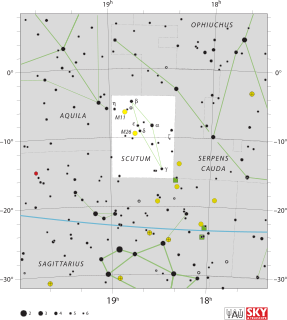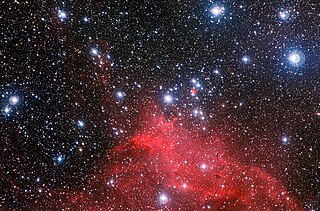
Galactic astronomy is the study of the Milky Way galaxy and all its contents. This is in contrast to extragalactic astronomy, which is the study of everything outside our galaxy, including all other galaxies.

Spiral galaxies form a class of galaxy originally described by Edwin Hubble in his 1936 work The Realm of the Nebulae and, as such, form part of the Hubble sequence. Most spiral galaxies consist of a flat, rotating disk containing stars, gas and dust, and a central concentration of stars known as the bulge. These are often surrounded by a much fainter halo of stars, many of which reside in globular clusters.

Perseus is a constellation in the northern sky, being named after the Greek mythological hero Perseus. It is one of the 48 ancient constellations listed by the 2nd-century astronomer Ptolemy, and among the 88 modern constellations defined by the International Astronomical Union (IAU). It is located near several other constellations named after ancient Greek legends surrounding Perseus, including Andromeda to the west and Cassiopeia to the north. Perseus is also bordered by Aries and Taurus to the south, Auriga to the east, Camelopardalis to the north, and Triangulum to the west. Some star atlases during the early 19th century also depicted Perseus holding the disembodied head of Medusa, whose asterism was named together as Perseus et Caput Medusae; however, this never came into popular usage.
A galactic halo is an extended, roughly spherical component of a galaxy which extends beyond the main, visible component. Several distinct components of galaxies comprise the halo:

The Orion Arm is a minor spiral arm of the Milky Way some 3,500 light-years across and approximately 10,000 light-years in length, containing the Solar System, including the Earth. It is also referred to by its full name, the Orion–Cygnus Arm, as well as Local Arm, Orion Bridge, and formerly, the Local Spur and Orion Spur.
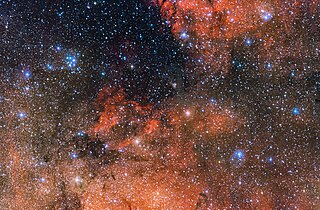
Messier 18 or M18, also designated NGC 6613, is an open cluster of stars in the constellation Sagittarius. It was discovered by Charles Messier in 1764 and included in his list of comet-like objects. From the perspective of Earth, M18 is situated between the Omega Nebula (M17) and the Sagittarius Star Cloud (M24).

Messier 37 is the richest open cluster in the constellation Auriga. It is the brightest of three open clusters in Auriga and was discovered by the Italian astronomer Giovanni Battista Hodierna before 1654. M37 was missed by French astronomer Guillaume Le Gentil when he rediscovered M36 and M38 in 1749. French astronomer Charles Messier independently rediscovered M37 in September 1764 but all three clusters were recorded by Hodierna. It is classified as Trumpler type I,1,r or I,2,r.

Messier 48 or M48, also known as NGC 2548, is an open cluster of stars in the constellation of Hydra. It was discovered by Charles Messier in 1771. There is no cluster in the position indicated by Messier. The value that he gave for the right ascension matches that of NGC 2548, however, his declination is off by five degrees. Credit for discovery is sometimes given instead to Caroline Herschel in 1783. Her nephew John Herschel described it as, "a superb cluster which fills the whole field; stars of 9th and 10th to the 13th magnitude – and none below, but the whole ground of the sky on which it stands is singularly dotted over with infinitely minute points". The brightest component is HIP 40348 at visual magnitude 8.3.

A galactic disc is a component of disc galaxies, such as spiral galaxies and lenticular galaxies. Galactic discs consist of a stellar component and a gaseous component. The stellar population of galactic discs tend to exhibit very little random motion with most of its stars undergoing nearly circular orbits about the galactic center. Discs can be fairly thin because the disc material's motion lies predominantly on the plane of the disc. The Milky Way's disc, for example is approximately 1 kpc thick but thickness can vary for discs in other galaxies.
The Monoceros Ring is a long, complex, ringlike filament of stars that wraps around the Milky Way three times. This is proposed to consist of a stellar stream torn from the Canis Major Dwarf Galaxy by tidal forces as part of the process of merging with the Milky Way over a period of billions of years, although this view has long been disputed. The ring contains 100 million solar masses and is 200,000 light years long.
In astronomy, a RAMBO or robust association of massive baryonic objects is a dark cluster made of brown dwarfs or white dwarfs.
In astronomy, stellar kinematics is the observational study or measurement of the kinematics or motions of stars through space. The subject of stellar kinematics encompasses the measurement of stellar velocities in the Milky Way and its satellites as well as the measurement of the internal kinematics of more distant galaxies. Measurement of the kinematics of stars in different subcomponents of the Milky Way including the thin disk, the thick disk, the bulge, and the stellar halo provides important information about the formation and evolutionary history of our Galaxy. Kinematic measurements can also identify exotic phenomena such as hypervelocity stars escaping from the Milky Way, which are interpreted as the result of gravitational encounters of binary stars with the supermassive black hole at the Galactic Center.

NGC 637 is an open cluster of stars in the constellation Cassiopeia. It has a Trumpler classification of I2m and an angular diameter of 4.2′. At a distance of approximately 7,045 light years, this corresponds to a diameter of 9.8 light-years (3.0 pc). The estimated age of this cluster is 5–15 million years.

NGC 654 is an open cluster in the constellation Cassiopeia. It was discovered by William Herschel in 1787. With apparent magnitude 6.5, it can be observed by binoculars. It is located 2,5° northeast of the star Delta Cassiopeiae. In the same low power field can also be seen the open clusters NGC 663 and NGC 659. It surrounds a 7th magnitude yellowish star, an F5Ia supergiant, which is a possible member of the group.

NGC 5316 is an open cluster in the constellation Centaurus. It was discovered by James Dunlop in 1826. Located approximately 4,000 light years away from Earth, it is located in the Carina-Sagittarius arm.
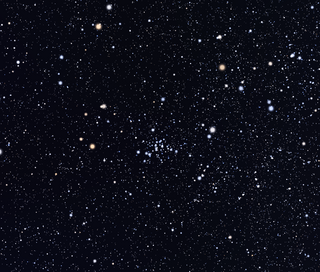
NGC 4103 is an open cluster in the constellation Crux. It was discovered by James Dunlop in 1826. It is located approximately 5,000 light years away from Earth, in the Carina-Sagittarius arm.
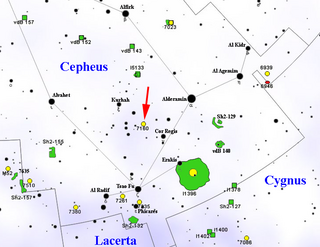
NGC 7160 is an open cluster in the constellation Cepheus. It was discovered by William Herschel on November 9, 1789. The cluster was also observed by John Herschel on October 7, 1829. It is a poor cluster and with little central concentration, with Trumpler class II3p. It is part of the stellar association Cepheus OB2, located one degree south-southwest of VV Cephei.




